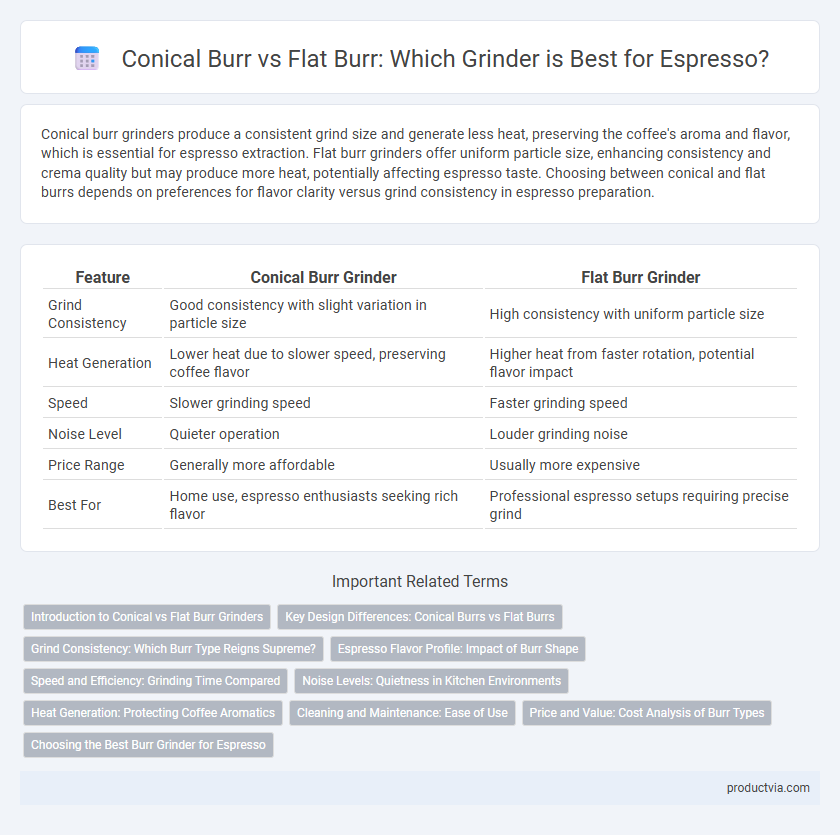Conical burr grinders produce a consistent grind size and generate less heat, preserving the coffee's aroma and flavor, which is essential for espresso extraction. Flat burr grinders offer uniform particle size, enhancing consistency and crema quality but may produce more heat, potentially affecting espresso taste. Choosing between conical and flat burrs depends on preferences for flavor clarity versus grind consistency in espresso preparation.
Table of Comparison
| Feature | Conical Burr Grinder | Flat Burr Grinder |
|---|---|---|
| Grind Consistency | Good consistency with slight variation in particle size | High consistency with uniform particle size |
| Heat Generation | Lower heat due to slower speed, preserving coffee flavor | Higher heat from faster rotation, potential flavor impact |
| Speed | Slower grinding speed | Faster grinding speed |
| Noise Level | Quieter operation | Louder grinding noise |
| Price Range | Generally more affordable | Usually more expensive |
| Best For | Home use, espresso enthusiasts seeking rich flavor | Professional espresso setups requiring precise grind |
Introduction to Conical vs Flat Burr Grinders
Conical burr grinders feature two cone-shaped burrs that work together to crush coffee beans with precision, producing consistent particle sizes ideal for espresso extraction. Flat burr grinders use two parallel rings to slice beans into uniform grounds, ensuring even extraction and enhanced flavor profile in espresso shots. Choosing between conical and flat burr grinders depends on preferences for grind consistency, heat generation, and noise levels, all critical factors for achieving optimal espresso quality.
Key Design Differences: Conical Burrs vs Flat Burrs
Conical burrs feature a cone-shaped inner burr that fits inside a hollow outer burr, producing a slower grind speed and less heat generation, which preserves the coffee's flavor and aroma. Flat burrs consist of two parallel, flat rings with sharp edges that crush beans between them, offering a more consistent grind size ideal for precise espresso extraction. The key design difference lies in grind speed and heat production, with conical burrs being quieter and better at retaining oils, while flat burrs provide uniform particle size for balanced espresso shots.
Grind Consistency: Which Burr Type Reigns Supreme?
Conical burr grinders deliver superior grind consistency by producing uniform particle sizes, essential for balanced espresso extraction and enhanced flavor clarity. Flat burrs also offer precise grinding but tend to generate more static and heat, potentially affecting particle uniformity and flavor stability. Overall, conical burrs reign supreme in maintaining consistent grind size, leading to more consistent espresso shots.
Espresso Flavor Profile: Impact of Burr Shape
Conical burr grinders preserve volatile oils and aroma compounds better, producing a richer, more complex espresso flavor with pronounced notes and balanced acidity. Flat burrs offer uniform particle size, resulting in a cleaner, brighter cup but may slightly mute the espresso's depth and body. Choosing between conical and flat burrs directly influences the espresso's flavor profile, affecting crema quality, extraction consistency, and overall taste intensity.
Speed and Efficiency: Grinding Time Compared
Conical burr grinders typically offer faster grinding speeds due to their design, which allows beans to be crushed between a stationary outer burr and a rotating inner burr, resulting in efficient particle size consistency. Flat burr grinders tend to produce a more uniform grind but often require slightly longer grinding times because the beans are crushed between two parallel flat burr surfaces, enhancing control at the expense of speed. For espresso grinding, choosing conical burrs can improve throughput in busy settings, while flat burrs prioritize grind precision and consistency.
Noise Levels: Quietness in Kitchen Environments
Conical burr grinders typically produce lower noise levels compared to flat burr grinders, making them more suitable for quiet kitchen environments. The design of conical burrs allows for slower grinding speeds and less vibration, resulting in reduced sound emissions during espresso preparation. Choosing a conical burr grinder helps maintain a peaceful atmosphere without compromising grind consistency or espresso quality.
Heat Generation: Protecting Coffee Aromatics
Conical burr grinders generate less heat during espresso grinding, preserving delicate coffee aromatics by minimizing flavor degradation. Flat burr grinders tend to produce higher friction and heat, which can accelerate the loss of volatile oils responsible for the coffee's aroma. Choosing a conical burr grinder enhances the retention of coffee's complex flavors and ensures a more aromatic espresso experience.
Cleaning and Maintenance: Ease of Use
Conical burr grinders generally require less frequent cleaning due to their design, which minimizes coffee buildup and clogs. Flat burr grinders, while offering consistent grind size, can accumulate oils and fines more quickly, demanding more regular maintenance to maintain optimal performance. Easy disassembly features in both types improve cleaning efficiency, but conical burrs often provide a simpler process for daily upkeep.
Price and Value: Cost Analysis of Burr Types
Conical burr grinders generally offer better value for espresso enthusiasts due to their lower price range, typically between $100 and $300, while delivering consistent grind quality suitable for home use. Flat burr grinders tend to be pricier, often ranging from $300 to over $1,000, but provide more uniform particle size distribution, enhancing espresso extraction and flavor precision. Investing in a flat burr grinder benefits professional settings where grind consistency and durability justify the higher cost, whereas conical burr grinders meet the affordability and performance needs of casual users.
Choosing the Best Burr Grinder for Espresso
Conical burr grinders produce consistent particle sizes with less heat buildup, preserving espresso's aromatic oils and flavor clarity, ideal for precision extraction. Flat burr grinders offer uniform grind distribution, enhancing espresso crema and intensity but may generate more heat, affecting delicate notes. Selecting the best burr grinder depends on balancing consistency, heat retention, and flavor preservation for your preferred espresso style.
Conical Burr vs Flat Burr for Espresso Grinding Infographic

 productvia.com
productvia.com